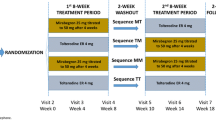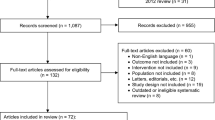Abstract
The efficacy and the tolerability of extended-release oxybutynin chloride, 10 mg daily, and extended-release tolterodine tartrate, 4 mg daily, in women with or without prior anticholinergic treatment for overactive bladder (OAB) were compared in a post-hoc analysis of data from the Overactive Bladder: Performance of Extended Release Agents (OPERA) trial. The patient population and study methods have been described previously (Diokno et al., for the OPERA Study Group, Mayo Clin Proc 78:687–695, 2003). Among the group with anticholinergic experience, extended-release oxybutynin was significantly more effective than extended-release tolterodine in reducing micturition frequency at last observation (p=0.052). Complete freedom from urge incontinence was reported by significantly more patients taking oxybutynin than tolterodine at last observation (23.6 vs 15.1%, p=0.038). In addition, among patients completing a full 12 weeks of oxybutynin treatment, significantly greater reductions were observed compared with those taking tolterodine on the primary efficacy variable, number of urge incontinence episodes (p=0.049), and the combined total of urge and non-urge episodes (p=0.012), although the differences between treatment groups were not significant at last observation. In the anticholinergic-naïve group, efficacy and tolerability outcomes were similar across treatments, except that oxybutynin was associated with a significantly lower frequency of micturition at last observation (p=0.035). No efficacy differences favoring tolterodine were observed, and tolerability of the treatments was comparable. Dry mouth (mostly mild to moderate in severity) was reported significantly more often among participants taking extended-release oxybutynin than extended-release tolterodine (32.2 vs 19.2%, p=0.004), but only among those with previous anticholinergic experience. Discontinuation rates were comparably low across groups. The results demonstrate the appropriateness of initiating treatment for OAB with extended-release oxybutynin, particularly in women presenting with incontinence.






Similar content being viewed by others
References
Abrams P, Cardozo L, Fall M et al (2002) The standardisation of terminology of lower urinary tract function: report from the Standardisation Sub-Committee of the International Continence Society. Am J Obstet Gynecol 187(1):116–126
Stewart WF, Van Rooyen JB, Cundiff GW et al (2003) Prevalence and burden of overactive bladder in the United States. World J Urol 20:327–333
Milsom I, Abrams P, Cardozo L, Roberts RG, Thüroff J, Wein AJ (2001) How widespread are the symptoms of an overactive bladder and how are they managed? A population-based prevalence study. BJU Int 87:760–776
Hu TW, Wagner TH, Bentkover JD et al (2003) Estimated economic costs of overactive bladder in the United States. Urology 61:1123–112
Brown JS, McGhan WF, Chokroverty S (2000) Comorbidities associated with overactive bladder. Am J Manag Care 6:S574–S579
Brown JS, Vittinghoff E, Wyman JF et al (2000) Urinary incontinence: does it increase risk for falls and fractures? J Am Geriatr Soc 48:721–725
Zorn BH, Montgomery H, Pieper K, Gray M, Steers WD (1999) Urinary incontinence and depression. J Urol 162:82–84
Liberman JN, Hunt TL, Stewart WF, Wein A, Zhou Z, Herzog AR et al (2001) Health-related quality of life among adults with symptoms of overactive bladder: results from a U.S. community-based survey. Urology 57:1044–1050
Stewart AL, Hays RD, Ware JE Jr (1988) The MOS Short-Form general health survey. Reliability and validity in a patient population. Med Care 26:724–735
Herzog AR, Fultz NH (1990) Prevalence and incidence of urinary incontinence in community-dwelling populations. J Am Geriatr Soc 38:273–281
Shaw C, Tansey R, Jackson C, Hyde C, Allan R (2001) Barriers to help seeking in people with urinary symptoms. Fam Pract 18:48–52
Dugan E, Cohen SJ, Bland DR, Preisser JS, Davis CC, Suggs PK et al (2000) The association of depressive symptoms and urinary incontinence among older adults. J Am Geriatr Soc 48:413–416
Milsom I, Stewart W, Thüroff J (2000) The prevalence of overactive bladder. Am J Manag Care 6:S565–S573
Goepel M, Hoffmann JA, Piro M, Rübben H, Michel MC (2002) Prevalence and physician awareness of symptoms of urinary bladder dysfunction. Eur Urol 41:234–239
Rovner ES, Wein AJ (2002) The treatment of overactive bladder in the geriatric patient. Clin Geriatr 10:20–35
Mostwin JL (2002) Pathophysiology: the varieties of bladder overactivity. Urology 60(5 Suppl 1):22–26 (discussion 27)
Burgio KL, Locher JL, Goode PS, Hardin JM, McDowell BJ, Dombrowski M et al (1998) Behavioral vs drug treatment for urge urinary incontinence in older women: a randomized controlled trial. JAMA 280:1995–2000
Burgio KL, Goode PS, Locher JL, Umlauf MG, Roth DL, Richter HE et al (2002) Behavioral training with and without biofeedback in the treatment of urge incontinence in older women: a randomized controlled trial. JAMA 288:2293–2299
Abrams P, Kelleher CJ, Kerr LA, Rogers RG (2000) Overactive bladder significantly affects quality of life. Am J Manag Care 6(Suppl 11):S580–S590
Wallace SA, Roe B, Williams K, Palmer M (2004) Bladder training for urinary incontinence in adults (Cochrane Review). In: The Cochrane library. Wiley, Chichester, UK (Issue 1)
Berghmans LC, Hendriks HJ, De Bie RA, van Waalwijk van Doorn ES, Bo K, van Kerrebroeck PE (2000) Conservative treatment of urge urinary incontinence in women: a systematic review of randomized clinical trials. BJU Int 85:254–263
Herbison P, Hay-Smith J, Ellis G, Moore K (2003) Effectiveness of anticholinergic drugs compared with placebo in the treatment of overactive bladder: systematic review. BMJ 326:841–844
Mattiasson A, Blaakaer J, Hoye K, Wein AJ, Tolterodine Scandinavian Study Group (2003) Simplified bladder training augments the effectiveness of tolterodine in patients with an overactive bladder. BJU Int 91:54–60
Gupta SK, Sathyan G (1999) Pharmacokinetics of an oral once-a-day controlled-release oxybutynin formulation compared with immediate-release oxybutynin. J Clin Pharmacol 39:289–296
Anderson RU, Mobley D, Blank B, Saltzstein D, Susset J, Brown JS (1999) Once daily controlled versus immediate release oxybutynin chloride for urge urinary incontinence. J Urol 161:1809–1812
Van Kerrebroeck P, Kreder K, Jonas U, Zinner N, Wein A, Tolterodine Study Group (2001) Tolterodine once-daily: superior efficacy and tolerability in the treatment of the overactive bladder. Urology 57:414–421
Diokno AC, Appell RA, Sand PK, Dmochowski RR, Gburek BM, Klimberg IW et al (2003) Prospective, randomized, double-blind study of the efficacy and tolerability of the extended-release formulations of oxybutynin and tolterodine for overactive bladder: results of the OPERA trial. Mayo Clin Proc 78:687–695
Ditropan XL (2004) Prescribing information. ALZA Corporation, Mountain View, CA, June 2004. Available at http://www.fda.gov/cder/foi/label/2004/20897se8-013_Ditropan_lbl.pdf
Detrol LA (2003) Prescribing information. Pharmacia & Upjohn, Kalamazoo, MI, July 2003
Author information
Authors and Affiliations
Corresponding author
Rights and permissions
About this article
Cite this article
Anderson, R.U., MacDiarmid, S., Kell, S. et al. Effectiveness and tolerability of extended-release oxybutynin vs extended-release tolterodine in women with or without prior anticholinergic treatment for overactive bladder. Int Urogynecol J 17, 502–511 (2006). https://doi.org/10.1007/s00192-005-0057-7
Received:
Accepted:
Published:
Issue Date:
DOI: https://doi.org/10.1007/s00192-005-0057-7




